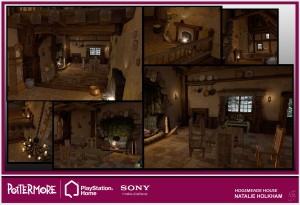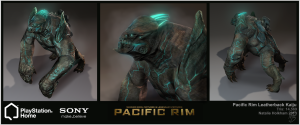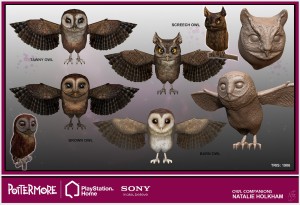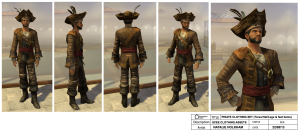Interviews with the Home Platform Group: Natalie Holkham
by NorseGamer, HSM Founder & Publisher
So if you remember The Matrix Reloaded, the whole film builds to the point where our hero finally comes face to face with the Architect: the intelligence behind the creation of the Matrix itself.
We’re about to embark upon the PlayStation version of that same journey.
For years, you’ve enjoyed PlayStation Home: its games, its quests, its social interactions. A wide array of development studios have become part of your world, all competing with various enticements to lure your wallet out. But who created Home? Who are the mysterious people, somewhere over there, who work in the shadows to bring Home to life and create the foundation and the tools used by everyone else? Do they wear three-piece suits and speak like a TRON mainframe?
Well, no. They’re actually a lot of fun. They’re the Home Platform Group.
Based out of SCEE London Studios, HPG are the architects of Home. Anything you’re capable of doing in Home – anything – starts with something HPG created. And it’s time to get to know the people behind the curtain.
First up: Natalie Holkham, HPG artist.
HSM: Thanks for consenting to be interviewed, Natalie. Could you give us a rundown of your key duties as a Home artist with HPG?
NH: Yeah, sure. I guess I am what they call a generalist artist in that I am tasked with creating all manner of assets for Home. This includes things such as props, furniture items, apartments, companions and clothing. We have a dedicated art team on the HPG, and we are responsible for creating a lot of different content between us in constantly varying styles. It can be very challenging at times but also very satisfying. I love seeing completed content that I’ve created go out to the public.
HSM: Interesting; it has to be a bit of a balancing act to get the art to look as good as possible while still coming in within the memory limitations. A Home Square set dressing, for instance, has to be very eye-catching while working within the budget.
NH: Yes, it is indeed. One thing HPG Artists come up against a lot is working with a limited amount of poly’s or texture memory. It is important to release content of the highest quality possible, and so sometimes we have to be a little imaginative in how we decide to model an asset or paint our texture maps to get the finished product looking as pretty as we can.
HSM: Of the various scenes and objects you’ve created for Home, which ones stand out to you as your personal favorites? What distinguishes those projects from the rest of your work?
NH: Hmm, well my favourite and most challenging scene I have created so far is something that hasn’t actually been published yet! So I can’t say all that much about it yet I’m afraid, but I did create the “House in Hogsmeade” personal apartment for Pottermore at PS Home. I enjoyed making that because it was the first environment work I had ever done professionally so it was a really great learning curve for me and I was kind of thrown in the deep end, but I’ve always loved a challenge! Pottermore was a good project because we wanted to make it some of the most beautiful content ever seen on Home, and so the standard had to be very high and we put a lot of detail and effort into everything we made – again this was difficult at times as we had very strict budgets to keep to in terms of memory. But I think we did pretty well considering. I also enjoyed making the owl companions for Pottermore because I love creating animals or creatures, and character work is my absolute favourite thing to do.
HSM: Let’s talk about your work prior to Home for a moment. How has your career within the games industry evolved?

NH: I actually come from a QA Testing background. I always knew from high school that I wanted to work as a games artist but had to start from the bottom and work my way up the ladder. My first job after leaving university was with Sega, I thought it was the best job ever as I got to play Sonic The Hedgehog all day sometimes looking for bugs! I spent two years there and then I got a job at 2K games where I eventually became a lead tester and worked on some amazingly fun titles such as The Darkness and Bioshock. After three years at 2K Games I saw a job advertised at Sony for a Tools Engineer on Home and thought it would allow me to expand further on my technical knowledge and I always like to push myself to learn new things and become better at what I do.
HSM: Bioshock? That must’ve been quite an experience!
NH: Yes it was! I have very fond memories of working on that game. It was fantastic to see it do so well on release too, plus I got some really cool freebies which I still keep in a display cabinet at home to this day, such as a really nice Little Sister figurine that was rewarded to all of the dev team that worked on the game.
HSM: You mentioned experience as a Sony Tools Test Engineer. If I understand correctly, that means testing out dev tools – such as a new Webmaf SDK or somesuch, for instance – before Sony puts them up on DevNet? Or did the role involve something else?
NH: Yes, the job of a Tools Engineer on Home is to ensure all of the Development Tools work properly so that the Art team/Designers can do their job, so for example I would have to test Maya tools and in-house software exclusive to the HPG. I had to learn a ridiculous amount of technical knowledge during my time as a Tools Engineer which was a bit daunting at times because you sometimes doubt you can remember it all, but it is very rewarding when you do! However, it was a demanding job as the tools were constantly being updated and every time new versions are released you have to start the testing cycle all over again.
HSM: What motivated you to progress from a testing/engineering track to a creative track? Simply the challenge of something new, or is artistry just in your blood? And how did that progression take place?
NH: I got my first console when I was six (an NES), and since I began playing games I knew it was something I wanted to be a part of straight away – I remember thinking to myself ‘Which persons job is it to make this and how do they do it?’. As I got older I developed a huge passion for art so I guess the two interests just married together and by the time I was in school I knew it was my dream career to make video games. I ended up studying art throughout school, and then I went to Art College and later did a degree at university in Graphic Design.
When I left university I applied to as many games artists jobs as possible and they all said they loved my work but as I couldn’t do 3D work they couldn’t employ me, and pure concept art work for games in the UK is extremely rare. So, when I began work at Sony and was lucky enough to have access to 3D Art software I began teaching myself how to 3D model, just during my lunch breaks and using online tutorials and experimenting.
Eventually, once I became better at it somebody on the HPG art team noticed my work while walking past my desk one day and was kind enough to give me a chance to create some assets and the rest is history! I have now been working as an artist on Home for just over two years.
HSM: How have the years of working within QA/QC processes as well as software engineering shaped your creative methodology? Do you simply create what you have in mind first and then optimize as needed, or is the TRC always in the back of your mind while you’re creating?
NH: Funny you should say that but yes I tend to QA my own work! The testing background is firmly ingrained into my being now so I can’t help but be a perfectionist and look for faults. I guess it’s not a bad thing though because it just means you don’t get assigned many bugs to fix further down the line.
HSM: Let’s talk about your personal gaming habits. Being involved in game development usually leaves precious little time to actually play games. What are some of the genres and titles you gravitate to?
NH: I can always find some time to play games somehow, mostly on the odd evening or on the weekends. My absolute favourite games are RPGs and FPS. I’ve always played the COD series, most recently Black Ops 2, and other games I’ve been playing lately are Skyrim and GTA V. Trevor is definitely my favourite character in that, he’s hilarious!
HSM: Interesting! Those are two wildly different genres to be immersed in. Is it a challenge to face the kind of time commitment something like a Skyrim or GTA V requires, given the demands of working in the industry?
NH: I guess so at times, but I tend to go through phases when playing games that are more immersive. For example, I might play something for a couple of hours here and there like Minecraft or BLOPS2 that I can just pick up and play briefly if I am short on time or other times when I do have more free time I’ll be playing GTA religiously every single night!
HSM: Time for some random trivia about yourself.
NH: Hmm well let’s see, I go through phases of liking cute animals and at the moment I am favouring penguins and kittens. My favourite colour is dark purple and I am totally addicted to watching the series Dexter. My fave sitcom of all time has to be Red Dwarf, as it is classic and still so funny every time I watch it, I just can’t get bored of it! I’m also partial to a bit of Family Guy and American Dad.
HSM: Red Dwarf! Awesome choice. Now we’re picturing Home with a Holly interface…
NH: Oh that would be so cool, wouldn’t it!?
HSM: Now what’s this, by the way, about you and Harry Potter witchcraft?
NH: Haha! Yes, I’m a former Quidditch captain for Gryffindor, don’t you know? However, I’ve always thought myself as more of a member of Hufflepuff. They always get a bad rep, bless them!
 HSM: You’re one of the architects of PlayStation Home. So let’s pose one of Home’s oldest questions: what is Home to you? What’s given it the sort of enduring appeal that’s kept it going for more than half a decade at this point?
HSM: You’re one of the architects of PlayStation Home. So let’s pose one of Home’s oldest questions: what is Home to you? What’s given it the sort of enduring appeal that’s kept it going for more than half a decade at this point?
NH: I think Home delights in being a little off the wall and different. It’s what you want it to be. It can be somewhere just to pop in and visit at times to take in the ever changing landscape or a totally immersive and addictive experience where you can whittle away the hours chatting to people. Personally I love visiting Home just to see what’s happening, and there’s always something that makes me laugh too – and who wants to be plain old ‘normal’ anyway?! It’s much better to be unique don’t you think?
HSM: Natalie, thank you so much for your time.
Speaking not just as a journalist, but also as a Home developer who’s worked with the HDK: what HPG has done — and continues to do — with Home is amazing. Our hope is that this new series of interviews with the architects of Home will not only provide a spotlight on the people who produce outstanding work behind the scenes every day, but help reinforce to the Home community that the people involved in creating and sustaining Home are just as emotionally engaged and passionate about it as the consumers who enjoy it.
HomeStation Magazine would like to thank Natalie Holkham, the Home Platform Group and SCEE for allowing this interview series to move forward. If you’d like to see more of Natalie Holkham’s portfolio, you can peruse her works here. Now go Home!
Share
| Tweet |






 LinkedIn
LinkedIn Twitter
Twitter
Great interview!
Very nice to hear from the people behind the scenes of Home. It is always a good thing to see the kind of passion that people put into their work and it shows that they really do care about Home and its future.